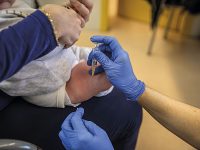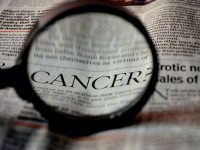
Recognising our reflection in a mirror is fundamental to everyone, although, rather than being something which is automatic from birth, it is something we learn as part of a process, just like many other things throughout our life. There are changes, injuries, accidents which might make us forget who we are, or make our own reflection seem foreign to us. An accident, an operation, or cancer can cause distress which goes deeper than just our feelings: they can cause permanent changes to the skin, which make it impossible to recognise, or identify with the person we were. That is why modern day medicine and the curing process do not end with a successful operation or when treatment comes to an end. The scarring goes deeper in many cases, since the patient wants to forget everything about what they have been through, and that, on many occasions, means erasing a mark or regaining something that was lost during the illness. And, although it might seem hard to believe, one type of unusual treatment could come in the form of a needle and a palette of colours to once again paint a face, a smile, or a nipple.
Everything may well have begun thousands of years ago. Let us meet the main player in the story… Ötzi was running faster than he had ever run before, down a mountain, danger hot on his heels and – with what might have been his last breath – he plucked the arrow from his chest which had pierced him from behind. Forty-five was a good age and his experience of hand to hand combat, added to skills as a hunter and archer told him to make one last effort if he wanted to survive. A moment later he fell – probably already dead – his head receiving one final blow. Although whether it was the final fatal blow from his own hunter, or from him striking a rock as he fell which eventually killed him we will never know. And it does not really seem to matter anyway.
«The Ice Man, with his 61 markings in the forms of straight lines and crosses – the reasons for which remain unclear – has left researchers dumbfounded»
5,300 years later, the man on the run – better known today as the «Ice Man» – was encountered by two hikers on an Alpine glacier close to the Italian-Austrian border and became the oldest mummy ever found. The man they wanted to take out has become a huge enigma to twenty-first-century researchers. In the purest Egyptian style, Ötzi seems to have been destined to be remembered forever. His body, battered by his harsh mountain lifestyle, keeps a secret which changes the way we look at history. The Ice Man, with his 61 markings in the forms of straight lines and crosses – the reasons for which remain unclear – has left researchers dumbfounded.
Magic and acupuncture
These 61 markings – divided into 19 groups of two, three and four parallel lines, as well as two crosses – could well be the first evidence that Bronze-Age man recognised the benefits of acupuncture. The markings, measuring between 0.7 and 4 centimetres long, «are made from a vegetable-based carbon pigment. A non-destructive analysis method was used», states researcher Marco Samadelli, one of the signees of the Ötzi tattoo study. The research team at the Institute for Mummies and the Iceman in Bolzano, Italy, have used multispectral image techniques to locate the marks since, with the passing of time, some have become invisible to the naked eye.
Ötzi had a degenerative disease, affecting the lower back as well as the joints. According to researchers, he possibly suffered severe pain in his legs, between his knee and his foot, where – by funnily enough – the majority of his tattoos were found. One follow-on hypothesis which carries a lot of weight is that these marks resulted from acupuncture treatment, or even as part of some magic ritual aimed at protecting these aching areas. Although researchers still do not agree on the reason for the tattoos, the Ice Man is for now the oldest tattooed man in history.
Tattooing as a punishment
«The symbolism tattooing holds has been used in many cultures throughout the ages»
The tattooing which we see nowadays is based on harmony, the beauty of colours. Culturally, tattooing is based on aesthetics, though it can hold a specific meaning for the wearer. In many cases it is a way of expressing in images something which cannot be expressed in words, something symbolic, or a way of remembering someone or something Yet for many others a tattoo is a decoration, like the colour of your hair or your make-up, though, of course, it is not temporary.
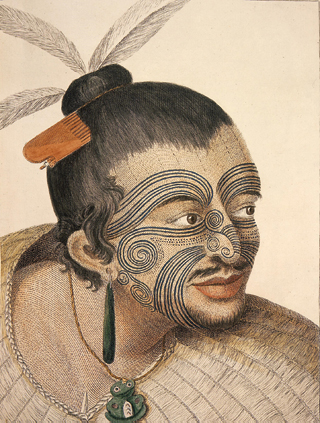
Maoris tattood their body before a battle in otder to scare the enemy, just as the cheeck lines we see in so many movies, used by several Indian tribes before fighting. / Mètode
The symbolism tattooing holds has been used in many cultures throughout the ages. The Maoris, for example, tattooed their bodies before going into combat to frighten the enemy, on the same lines as Hollywood American Indian tribes painting lines across their faces in the lead up to battle. In North America, native Indians used these markings in rituals associated with age and hierarchy: tattoos were used to protect the person’s soul, during a rite of passage ceremony into adulthood.
But a line which cannot be erased can have many uses. The oldest book in classical Japanese, The Nihonshoki, which dates from the seventh century, tells the story of an Emperor who punishes a traitor for tattooing his face. At that time Japan was under the authority of Confucianism which did not allow any alteration or damage to the skin in any way, and that included tattooing.
However, this type of permanent marking also started to take on a new use: to mark delinquents for life. A circle was tattooed on the criminal’s arms and wrists, both as a means of identification and to further exclude them socially. As of then, a new movement was born in the world of tattooing which centred around hiding these signs of dishonesty, covering up the signs of crime. And so many ex-prisoners started to decorate their tattoos with more ornate designs, both to conceal and to embellish their ink brandings. And it continues up until today.
Coloured labels
The information these colours on the skin give can be more or less obvious. Some without doubt are negative, though many others send real messages and can save lives. Who has not seen medical I.D. dog-tags or bracelets in films where medical information like allergy or blood type is usually kept? A longer lasting way to give information about a medical problem is to always carry it with you, but the neck-chain with all your information could break. What would happen following a nuclear disaster? During a war, how would we face the need for an urgent blood transfusion? As we know today, not all blood types are suitable for everyone, so identifying blood types is fundamental, and it must be done quickly. The United States took the lead in this field during the Korean War in the early 1950s. With the aim of identifying potential donors if a blood transfusion was required urgently, several programmes were set up identifying the blood groups of the whole population, creating donor lists, and, if permitted, tattooing this information on every individual. The project, which in the end was only carried out on two small American communities, managed to identify the blood groups of, and tattoo, thousands of people. Eventually, interest in donating began to fade with the ending of the Korean conflict, for health reasons such as possible infections, a preference to wear dog-tags, the time required to carry out the project, and due to some religions prohibiting tattooing.
«Many decide to use tattooing as a way to cover up their vitiligo (the depigmentation of the skin caused by other illnesses), as well as scars as a result of wounds, operations, or burns»
Although these projects did not work on a large scale as intended, today, on a personal level, there are a lot of people who tattoo medical information on their bodies and it is not difficult to find people who have a tattoo on their arm or chest with the English words diabetic, pace-maker, or epileptic. Although these types of tattoos have no legal implication, they can help doctors when it comes to orientating a patient’s treatment, like for someone with a penicillin allergy, or with some other condition explained on their tattoo. Indeed, there are some marks which many patients wear with pride. These survivors – those fighters who have taken on an illness and won – wear those droplets of ink like someone wearing a medal. I am talking about those cancer patients who have had to undergo radiotherapy. In this case, the tattoo, in the form of tiny blue or black spots of ink, have the singular, clear objective of directing the beam of light during radiotherapy, and of keeping the exposed, irradiated area to a minimum. In this way, the damage done to the surrounding tissues can be minimised. And for those who later become tired of seeing the marks, they can be removed with laser treatment, thereby putting the months of treatment and hours in hospital to the back of their minds.
«On a personal level, there are a lot of people who tattoo medical information on their bodies»
Yet there are other patients who decide that they have gone through enough, and that their time has come. In such cases the letters DNR – standing for Do-Not-Resuscitate – tell the doctor not to carry out any resuscitation treatment. Although the practice is not that common in Spain, in countries like the U.S. or Canada, it is quite common.
Recovering their identity
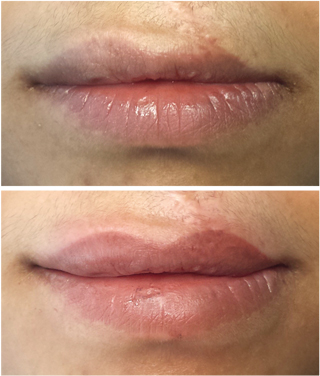
When we think about permanent makeup, we tend to think about lip or eyebrow liners, but that is only a hobby, taking into account what this technique can achieve today. / Sara Ortuzar
Whilst the model Winnie Harlow became an example of how the depigmentation of the skin caused by vitiligo can be beautiful following her appearance in an advertising campaign for a well-known clothes brand, there are many people who still do not want to show theirs. Therefore, many decide to use tattooing as a way to cover up their vitiligo (the depigmentation of the skin caused by other illnesses), as well as scars as a result of wounds, operations, or burns. If you mention permanent makeup, people instantly think of shaping the lips, or augmenting the eyebrows to give more depth to a look, but this fades into insignificance when you consider what can be done with tattooing techniques nowadays. In the past, the only way to conceal unattractive scars in the wake of a terrible injury or an operation was, literally, to cover it with such an eye-catching tattoo that the damaged skin was invisible. Today things have changed. Now many people seek to disguise the damaged area by tattooing it back into its original, pre-damaged colour.
One quite drastic example is of the American woman of Iraqui descent, Basma Hameed. At the age of two, 40% of her face was burnt by oil in a domestic accident. Following fifteen years of treatment, and over 100 operations, her face, although improved, still showed the scars. After surgery to reduce scars, as well as skin and hair transplants, her doctors assured her that nothing more could be done to improve her appearance. She then set off on a long voyage, which led her to tattooing herself and, later, to turn this technique into a business. Hundreds of people now come to her every year to erase marks bringing back the look they recognise in a mirror.
The aim of colouring over an area of one’s skin in to reclaim one’s inner self, curing the emotional scars of an accident, or eliminating the memories of an illness which one hopes will not return. What someone has gone through will always remain as a memory, but today not everyone needs to see them. Today we can show the side we choose to, the person who has won.
The icing on the cake
Throughout time, tattoos have gone from being simple lines to mottled, almost impossible designs, and from simple black tattoos, the art slowly developed to become multi-coloured. And now we see the introduction of tattoos in three dimensions which strive to put «the icing on the cake» and fill in, physically and emotionally, the void left by a mastectomy.
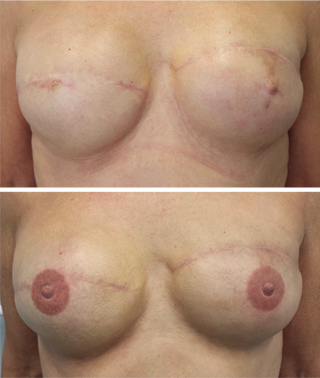
Through a technique that combines artistic tattooing and micropigmentation, therapeutic tattooing can recreate the nipple and areola in women who have undergone a mastectomy and the subsequent surgery reconstruction of the breast. / Sara Ortuzar
A breast cancer patient has to go through a series of processes in order to get over her illness. One of the first stages is the treatment: an operation to remove the cancer, and with it something so inherent in a woman, so intimate, her breast. Then begins chemotherapy treatment and, once the cancer is over – once the disease has disappeared – a scar, or the absence of something as fundamental, as «normal» as a nipple, is a daily reminder of the illness, making her feel incomplete. With the reconstruction of the breast, there only remains the missing nipple, something which cannot be recovered in an operating theatre. The technique of creating an illusion, an illusion in the purest Da Vinci style, consists of painting a nipple and areola in 3D in order that, with this therapeutic tattoo, many women can reach the end of their journeys which began with being diagnosed with cancer, or when a preventative mastectomy was carried out. One of the world’s biggest experts is Vinnie Myers, an American doctor who, for the last 15 years, has been tattooing women, reinstating with «magic» paint a nipple or an areola lost to cancer.
Sara Ortuzar is one of the few female tattooists doing this type of tattooing in Spain. She began specialising, almost by chance, a few years ago, when a woman came to her previous studio asking for a tattoo of the areola she had lost during a mastectomy. Having never previously done such a job, Ortuzar initially refused, but then her profession changed course and she decided to specialise in this field of tattooing. Her pioneering work, a blend of artistic tattooing and micropigmentation, is done with the latest generation of tattooing machines which are minimally invasive to the skin. «The result is that I am now able to offer personalised treatments with areolas which, rather than being standard, are adapted to each person as every tattoo is a one-off. The 3D effects stem from artistic tattooing and the essentials of hyper realistic painting where we play with colour, light and shade to create the effect of volume wherever we want. It is similar to painting a picture, though here skin is the canvas and the tattoo machine is the brush», underlines the female tattooist.
Ortuzar points out that during their check-ups, women are told that the most important thing for a woman after getting over cancer is getting back to day-to-day life. Yet it is in day-to-day life that problems suddenly come up, like getting changed at the pool, or going for a massage. «It is in the simplest situations that mastectomy patient feel themselves to be in the spotlight, since a missing areola, or scars on the breast attract a lot of attention. And that is not to mention intimate relations, or mothers of young children, who will not show their children their bodies until after they have been tattooed so it will not look strange to the kids» the tattooist stresses.

Sara Ortuzar is one of the few Spanish tatto artists who tattoo in 3D to restore the nipple and areola after a mastectomy. / Sara Ortuzar
Today in hospitals, micropigmentation is now also being included in hospital treatment, the work being carried out by doctors and nurses. But before this possibility became available in hospitals, Cova Saras, one of the founders of «Despechadas» (The Alienated), a charitable association, required it. She was diagnosed with cancer at 31, her treatment ending with her tattoo when she was 33. «This illness, with all its treatment can be long, but it did not come to an end for me until I was tattooed. That is when it all ended. The results are spectacular.» As she says, it was not very common at all in Spain when she needed it. «I decided to set up an association, and at the same time the first project named «The icing on the cake» was born. We went to the USA to be tattooed by Meyers. I liked having it done in a tattoo centre rather than a hospital, that way you get a change of air. There was a party feel to the whole thing, being away from the hospital walls which only remind you of the illness», she comments. «This option allows you to look at yourself in the mirror as if nothing had happened. One of the problems related with this illness is exactly that: the operation leaves such visible scars, and the damage to such a feminine body part as is the breast. In addition, with you finish it off with a tattoo, which is like a new beginning», notes Saras.
Whether they are vertical lines applied with basic tools, like a wooden spatula, or with the precision of a surgeon holding a needle instead of a scalpel, these war paintings of warriors do not scare the enemy anymore, because the enemy has already been defeated. Instead what cures the personal battle wounds is a colourful trophy of a battle won. These tattoos cure hidden wounds: those which were caused by sleepless nights, by tears, and by the fight – those which science cannot cure.




